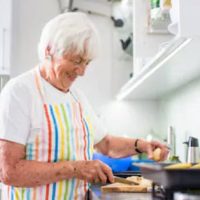Kitchen Safety for Older Adults

As experienced Bronx & Westchester Medicaid and nursing home attorneys, we know how important it is for most older adults to remain in their homes as long as possible. We also know how easily accidents and injuries can occur. Even a minor mishap can result in health setbacks that require extensive medical treatments while more major injuries can hasten the need for long term care.
One of the most important areas to address safety issues in any home is the kitchen. The following offers tips designed specifically to protect seniors.
Common Kitchen Hazards for Older Adults
Many older adults love cooking, whether it involves creating elaborate feasts for their families or simply making smaller meals for themselves. Serving up traditional dishes can be a way to pass along family memories and is a fun hobby. However, it does create certain risks. According to the U.S. Fire Administration, home fires are one of the biggest dangers facing older adults. These often start in the kitchen. Common hazards to be alert for include:
- Gas stoves with poorly functioning pilot lights;
- Electric ovens and stovetops without automatic shut offs functions;
- Appliances that are placed too close to hanging curtains or towel racks;
- Not having fire alarms in and around the kitchen;
- Not keeping a fire extinguisher nearby and failing to check it regularly.
Additional and common kitchen hazards for older adults include uneven floors and loose flooring materials, having to stand on step stools to reach shelves, and having an excess amount of clutter in the area, all of which increase the risk of slips, trips, and fall injuries.
Kitchen Safety Tips for Seniors
For older adults, the general idea is to make the kitchen area both as safe and accessible as possible. Having to reach for items that are placed high on shelves or needing to pull dishes, pans, or other heavy objects from low hanging drawers only increases the risk of serious injuries. In addition to falls, broken bones, problems with joints, muscle strains, and other types of soft tissue injuries are all common problems. To protect your loved ones and make kitchen tasks easier, Age In Place offers the following tips:
- Make sure there is adequate lighting in the kitchen, with switches near entrances;
- Install night lights in key locations;
- Make sure all kitchen appliance controls are clearly marked and have an automatic shut off valve;
- Allow for plenty of counter space, where items that are used regularly can be kept;
- Use higher shelves only for more long term storage needs;
- Install new, non-slip flooring materials;
- Increase ventilation in the area as needed and make sure vents are clean;
- Make sure any hazardous substances are kept outside in garages or storage sheds.
Let Us Help You Today
For additional ways to protect older adult friends or family members both now and in the years to come, reach out to Cavallo & Cavallo. Call or contact us online to request a consultation in our office today.
Resources:
usfa.fema.gov/downloads/pdf/publications/fa_221.pdf
ageinplace.com/at-home/home-safety/elderly-kitchen-safety/
https://www.cavallolawyers.com/attic-conversions-allow-aging-in-place-for-older-adults/
